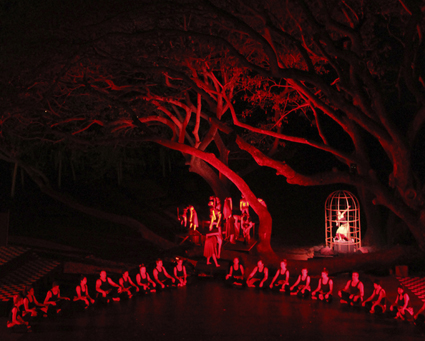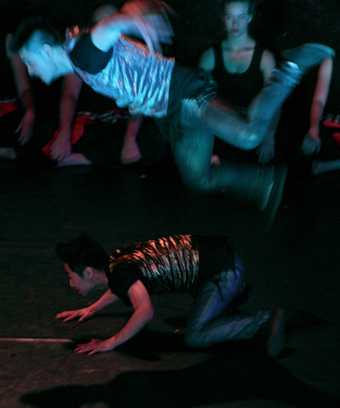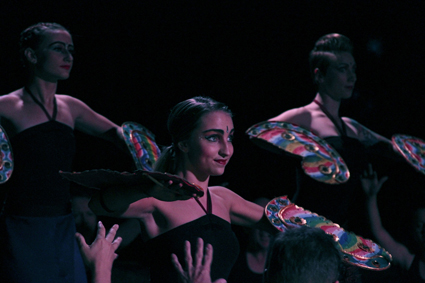Kecak, breakdancing, tension & harmony
Kyle Walmsley: Tracks Dance Company, Zombies In the Banyan Tree

Zombies in the Banyan Tree, Tracks Dance Company
photo Jess Devereux
Zombies in the Banyan Tree, Tracks Dance Company
A balmy Darwin night, the sticky beginnings of the build up, nestled under a rain tree in the Botanical Gardens—you’d almost think you were just hanging out in Festival Park if it weren’t for that wave of zombies approaching.
Tracks Dance Company’s latest production, Zombies in the Banyan Tree, takes the traditional Hindu story of the Ramayana and spins it on its head by mashing it with break, contemporary and Balinese dancing, a traditional Kecak choir and a beatboxer. This is a recipe with a lot of chefs involved. One look at the credits attached to the production and you get a taste of what Tracks is renowned for—bringing together a whole heap of people who are passionate about dance from all around the world, to work with a team as diverse as the work itself.
Most of my dance training comes from obsessive addictions to TV shows such as Dance Moms and So You Think You Can Dance—which I think qualifies me to speak quite proficiently on the nature of off-stage arguments had by dancers moments before performing. Unfortunately this didn’t come in handy at all. What was evident in this dance work was the opposite—joy resonating out from the performers.

Zombies in the Banyan Tree, Tracks Dance Company
photo Jess Devereux
Zombies in the Banyan Tree, Tracks Dance Company
The story told is of Butterfly spirits who come up against Demons of the underworld in some contemporary/break dance fighting. They feud and a Butterfly is captured in a giant cage. The Butterflies and Demons face off, slowly destroying each other—the dead becoming the undead as their movements become zombified. The last Butterfly and the last Demon face off in a battle. After the Butterfly Goddess is freed from her cage in order to restore balance in the nick of time, the Butterfly and Demon each find a moment of quiet redemption at the other’s flower-filled pond.
My first experience of Kecak dancing was in Bali, at a traditional ceremony, complete with rogue fireballs and people performing a ritual from their own culture. Here in Darwin, where performing the piece lends itself to a little contextual cultural confusion, the performers chanting the Kecak “chk-chk” manage a fair representation of the ceremony. It’s reminiscent of a really rhythmical group of crickets, locusts and chickens, who for some reason have all decided to form a band. The hypnotic ostinatos are reminiscent of Steve Reich and the effect of this rhythmical soundtrack is energizing.

Zombies in the Banyan Tree, Tracks Dance Company
photo Jess Devereux
Zombies in the Banyan Tree, Tracks Dance Company
The show’s contemporary soundtrack is provided by the beatboxing of K FUZZ. I really wanted to see more of K FUZZ but unfortunately he had to work his magic and his looping machine from the side in the shadows. He revealed an incredible sonic range—evoking everything from the cracking of zombie skeletons to the synthesizer of Michael Jackson’s “Thriller,” and every beat in between. This live accompaniment brought another very real and present anchor to the action—and all done through the sounds made by the musician’s mouth, microphone and looping. Howling winds were precisely managed and every pop, squelch and plosive was expertly timed alongside the action.
The live beatboxing joined the chorus to take Kecak into 2013. Seated in a circle the chorus for the most part occupied the centre of the stage, shaping the performance space along with its platforms and lighting divisions. One highlight for me was the sweeping walk, or stage cleanse, when the chorus took control forcing the zombies to their corner and the butterflies to theirs.
At the show’s end we’re reminded of the importance of balance as the rescued deity steps forward and everyone falls into place. The final image is of the breakers and the butterflies in balance either side of the princess and the Kecak choir. Once again peace is restored, and we are all living harmoniously beneath the Banyan tree.
Sydney based choreographer Nick Power guided the breakdancers throughout the creative process. We see what happens when breakdancers are provided with structure, taking their style and uniqueness through a process of professional guidance—SHAZAM! In fact, these are the moments that are most alive in the piece. The breaking, particularly in the battles with the butterflies, is fierce and electric. To see breakdancing used to drive a narrative is a step forward for the style.
Apparently the zombies had not watched a single episode of So You Think You Can Dance. As any casual viewer would be able to tell you—breakdance never wins against contemporary.






